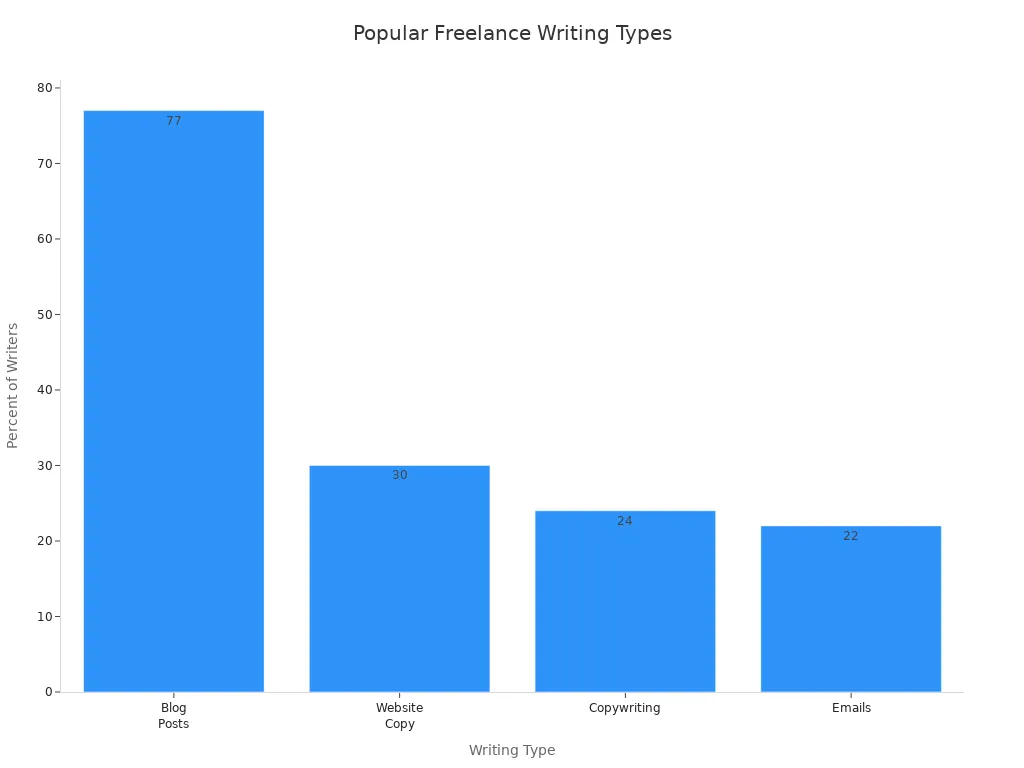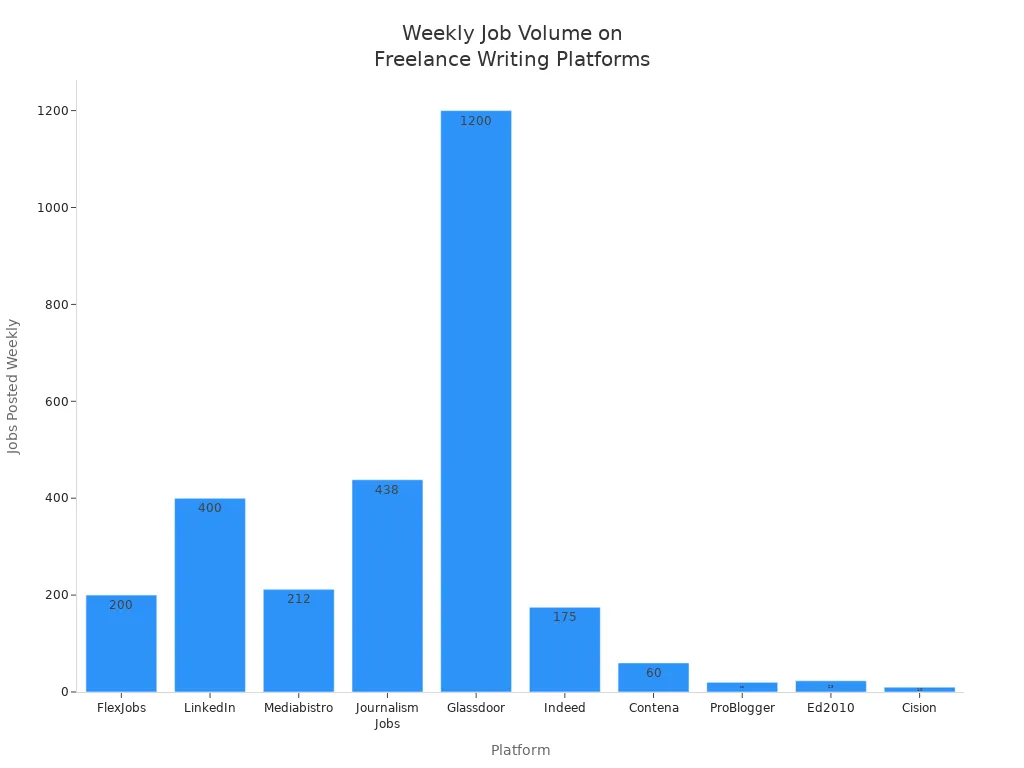- EasyCard
- Trade
- Help
- Announcement
- Academy
- SWIFT Code
- Iban Number
- Referral
- Customer Service
- Blog
- Creator
The Beginner’s Roadmap to Freelance Writing Success

Image Source: unsplash
If you wonder how to start freelance writing, you do not need any experience to get going. You can become a freelance writer by picking topics that interest you and practicing your skills every day. Many successful freelance writers begin by setting clear work hours, staying organized, and creating a quiet space to write. You will learn how to manage your time, meet deadlines, and build your portfolio as you grow. Strong communication helps you connect with clients and keeps your freelance writing projects on track. As a freelance writer, you will also learn to handle payments and keep good records. Your freelance writing career starts with one step, so get ready to take it.
Key Takeaways
- Choose a niche you enjoy and know well to stand out and earn more as a freelance writer.
- Try different writing types like blog posts or copywriting to find what fits your skills and goals.
- Build a strong portfolio with quality samples and a simple website or online profile to attract clients.
- Set fair rates based on your experience and niche, and communicate your prices confidently.
- Use job boards, pitch to clients, and keep learning to find work and grow your freelance writing career.
How to Start Freelance Writing

Image Source: unsplash
Find Your Niche
When you start your freelance writing journey, the first step is to choose a niche. This means picking a topic or industry you want to write about. You might wonder how to start freelance writing if you do not have much experience. The answer is simple: begin with what you know or enjoy. Think about your hobbies, school subjects you like, or even topics you read about for fun. If you love fitness, health, or technology, these can all become your focus.
Choosing a niche helps you stand out as a freelance writer. Clients look for writers who know their subject well. When you specialize, you can charge higher rates and get more job offers. For example, health writing is a popular niche. Many magazines and websites need articles about diet, fitness, and beauty. Finance, technology, and travel are also in high demand. Here is a table showing some of the most in-demand freelance writing niches and their average pay:
| Niche | Description and Demand | Average Salary / Pay Example |
|---|---|---|
| Finance | High demand from banks, credit card companies, financial firms | $52,000/year |
| Cryptocurrency | Growing sub-niche; blockchain, bitcoin, crypto topics | Starting around $1,000/month |
| Health and Wellness | Includes pharmaceuticals, diet, fitness, beauty | High-paying, but competitive |
| Technology Writing | Covers tech topics; needed for tech companies and forums | High demand, premium rates |
| Travel | Storytelling and personal experience needed | $52,000/year |
Specializing in a niche can help you earn more. Some writers who focus on technical topics, like cybersecurity or sustainable energy, have doubled their income in just a few years. You can also find steady work and build a strong reputation. A 2023 report found that freelance writers who specialize earn about 40% more than those who write about everything.
Tip: Use job boards like Upwork or Freelancer to see which topics are popular. You can also use tools like Google Analytics or BuzzSumo to find trending subjects.
If you want to know how to choose your freelance writing niche, start by making a list of your interests and skills. Try writing a few sample articles in different areas. Over time, you will see which topics you enjoy most and which ones get the best response from clients.
Choose Your Writing Type
After you choose a niche, you need to decide what types of freelance writing you want to do. There are many options, and each one has its own style and pay rate. Some of the most popular types of freelance writing for beginners include blog posts, website copy, emails, and copywriting. Blog posts are a great place to start because they are always in demand and help you build your skills.
Here is a chart showing the most common types of freelance writing for beginners:

You can also look at the table below to compare the pay rates for different writing types:
| Writing Type | Entry Level (0-2 yrs) | Intermediate (2-4 yrs) | Senior (4+ yrs) |
|---|---|---|---|
| Technical Writer | $58,000 | $69,600 | $86,800 |
| Copywriter | $51,597 | $66,257 | $80,828 |
| Content Writer | $46,201 | $57,967 | $79,880 |
| Journalist | $37,357 | $43,642 | $54,841 |
Technical writing pays the most, but it often needs special knowledge. Copywriting and content writing are also good choices. You can write website pages, product descriptions, or customer stories. Journalism pays less on average, but it can be exciting if you like news and interviews.
You do not have to pick just one type right away. Try writing a few blog posts, some website copy, or even a short email series. This will help you learn what you enjoy and what clients want. As you get more experience, you can focus on the writing types that fit your skills and goals.
Note: Many freelance writers start with blog posts and content writing because these jobs are easy to find and help you build a strong portfolio.
Learning how to start freelance writing is easier when you focus on a niche and a writing type. This focus helps you get noticed, build your skills, and grow your income as a freelance writer.
Create an Outstanding Portfolio

Image Source: unsplash
A strong portfolio helps you stand out as a freelance writer. When you want to know how to create a freelance writer portfolio, you need to show your best work and make it easy for clients to see your skills. Let’s break down the steps for building a portfolio that gets noticed.
Build Writing Samples
You do not need paid work to start. You can write great sample work on topics you enjoy or know well. Most experts suggest you include three to five samples in your portfolio. Try to show different types of writing, such as blog posts, articles, product descriptions, or even social media posts. Quality matters more than quantity. Make sure each sample is clear, well-written, and fits the kind of freelance jobs you want.
Tip: Guest posting on blogs or publishing on Medium can help you get your first samples. You can also write mock articles for brands you like.
Set Up a Website or Blog
A simple website or blog makes your portfolio look professional. You do not need fancy designs. Focus on easy navigation and a clean look. Put your best and most relevant work on the first page. Add a short bio, a photo, and a way for clients to contact you. If you want to know how to create a freelance writer portfolio that stands out, update your site often and organize your samples by type or topic.
Here are the key elements of a strong freelance portfolio:
- A variety of writing types
- Your best work at the top
- Easy-to-find categories
- Personal touches like a bio or favorite quote
- Testimonials from happy clients
Use Online Platforms
You can create a portfolio on free platforms if you do not want to build a website right away. Sites like Medium, LinkedIn, and even Instagram let you share your writing and connect with clients. Some writers use platforms like Fourthwall to sell e-books or offer writing tips. Job boards such as ProBlogger, FlexJobs, and Fiverr also let you display samples and get feedback from clients.
| Platform | Key Features for Writers | How Clients Engage |
|---|---|---|
| Medium | Easy publishing, wide audience | Comments, shares |
| Professional network, sample sharing | Direct messages, endorsements | |
| Fiverr | Gig creation, sample display | Reviews, tiered service feedback |
| Fourthwall | Sell products, build brand | Memberships, exclusive content |
When you focus on building a portfolio, you show clients you are ready for freelance work. If you want to create an outstanding portfolio, keep it fresh and always add your best new work. Learning how to create a freelance writer portfolio is one of the most important steps in your freelance journey.
Set Your Rates
Understand Beginner Pricing
Setting your rates as a new freelance writer can feel tricky. You want to get paid fairly, but you also want to land your first jobs. Most beginners in the United States start with these rates:
- $0.15 to $0.20 per word is a good starting point for freelance writing.
- Rates below $0.04 to $0.08 per word usually mean low-quality, low-paying jobs.
- Blog posts can pay anywhere from $25 to $1,000 each, depending on the client and topic.
- Writing a single email often starts at $150 per project.
Your rate depends on your niche, skill level, online presence, and the type of client you work with. Some freelance writers charge by the hour, while others use flat rates or value-based pricing. Here is a table showing how rates can change based on writing type or niche:
| Writing Type / Niche | Rate Range / Example | Notes on Variation and Context |
|---|---|---|
| Feature Articles | $0.65 - $1.00 per word | Rates often fixed; can rise with experience. |
| Flat Rate Articles | $200 flat rate | Some editors pay a set fee, no matter the word count. |
| Hourly Rates | $45 - $140 per hour | Lower for non-profits, higher for corporate clients. |
| Copywriting / Content Marketing | $400 for 250 words (~$160/hr) | Value-based pricing can pay more than hourly or per-word rates. |
| Corporate Writing | $160 - $300 per hour | Experienced freelance writers often charge these rates for project work. |
| Sponsored Content | $650 for 2.5 hours | Sponsored posts can pay well, especially in certain niches. |
You can adjust your rates as you gain more freelance experience and build your portfolio.
Communicate Rates Professionally
Talking about money with clients can feel awkward, but you can do it with confidence. Here are some tips to help you discuss your freelance rates:
- Add a little extra time and money to your first quote. This gives you room to negotiate.
- Always share your minimum rate before you start talking about the project.
- Show your value by sharing stories of past client success or special skills.
- Offer a small trial project if the client feels unsure.
- Change the project scope if the client has a tight budget.
- Sometimes offer a lower rate for ongoing or repeat freelance work to build relationships.
- Research what other freelance writers charge so your rates stay fair.
- Stay confident during negotiations and know when to walk away from low offers.
- Plan to raise your rates over time, especially for long-term contracts.
Tip: Practice your rate conversations with a friend or in front of a mirror. The more you practice, the easier it gets.
When you set clear freelance rates and talk about them professionally, you show clients that you take your work seriously. This helps you build trust and grow your freelance writing career.
Find Freelance Writing Clients
You want to land your first freelance writing job, but you might not know where to look. Many new freelance writers feel the same way. The good news is, you have lots of options to find writing gigs and start building your career.
Job Boards and Marketplaces
You can find freelance writing jobs on many online job boards and marketplaces. These sites list hundreds of new gigs every week. Some focus on beginners, while others offer higher pay for experienced writers. Here’s a table to help you compare the top platforms:
| Platform | Cost to View | Typical Rates | Jobs Posted Weekly | User Review Highlights |
|---|---|---|---|---|
| FlexJobs | $15/month - $50/year | $10-$40/hour; $100-$125/article | ~200 | Curated listings, high-quality employers, flexible schedules, good for all levels. |
| Free and paid | $20-$30/hour; $15-$250/article | 400 | Big companies, good pay, includes ProFinder for freelancers. | |
| Mediabistro | Free | $20-$75/hour; $45k-$110k/year | 212 | Niche jobs, good for targeted writing. |
| Journalism Jobs | Free | $15k-$68k/year full-time | 438 | High volume, some freelance gigs, wide pay range. |
| Upwork | Free | Varies widely | Very high | Highly competitive, some high-paying gigs. |
| ProBlogger | Free | $7-$300/article | 20 | Good for bloggers, niche jobs. |
| Glassdoor | Free | $50-$250/article; $11k-$132k/year | 1,200 | Big companies, remote jobs, good pay range. |
You can see which sites post the most jobs each week in this chart:

Try several platforms to see which ones fit your style. If you want to know how to get copywriting clients, Upwork and LinkedIn are great places to start. You can also pitch yourself everywhere—on social media, in online groups, or even by emailing companies directly.
Pitching to Publications
You might wonder how to pitch for jobs and get noticed by editors. Most freelance writers send cold pitches to magazines, blogs, or businesses. The truth is, the average response rate for cold pitches is very low—about 1%. Less than 24% of editors even open these emails. But don’t let that stop you. Some writers, like Bree Weber, have reached a 100% response rate by using a smart, ethical approach. You can improve your chances by following these tips:
- Research each publication and tailor your pitch to their style.
- Keep your pitch short and focus on what you can do for the editor.
- Follow up if you don’t hear back after a week.
- Use more than just email—try social media or even a phone call.
- Pitch yourself as a problem-solver, not just a writer.
If you want to find writing gigs, stay consistent and keep sending pitches. The more you pitch, the better you get.
Overcome Rejection
Every freelance writer faces rejection, especially in the first year. You might feel discouraged, but rejection is normal in freelance writing. Many famous authors, like J.K. Rowling and Stephen King, faced dozens of rejections before finding success. Here’s how you can handle it:
- Don’t take rejection personally. Editors have many reasons for saying no.
- Give yourself time to process before you analyze what went wrong.
- Talk to other freelance writers for support.
- Keep working on new projects so you don’t get stuck on one “no.”
- Turn rejection into a challenge—see how many you can collect and learn from each one.
You build resilience by facing rejection and moving forward. If you keep pitching and improving, you will find freelance writing jobs that fit you. Remember, persistence is key. Pitch yourself everywhere, keep learning, and your freelance writing career will grow.
Essential Tools for Freelance Writing
Writing Apps and Organization
You need the right tools to stay organized as a freelance writer. Many apps help you write, plan, and manage your projects. Some apps focus on writing, while others help you track tasks or store ideas. Here is a table with some of the most recommended writing and organization apps for freelance writers. These ratings come from professional reviews and user feedback.
| App | Main Function | Key Features | Pros | Cons | Pricing (USD) | User Rating (G2) |
|---|---|---|---|---|---|---|
| Google Docs | Writing | Real-time collaboration | Free, easy sharing | Needs internet | Free | 4.7/5 |
| Scrivener | Writing/Planning | Project management, templates | Great for long pieces | Learning curve | $59 one-time | 4.6/5 |
| Trello | Organization | Boards, lists, cards | Visual, flexible | Can get cluttered | Free/$5 month | 4.4/5 |
| Notion | Notes/Database | All-in-one workspace | Customizable | Can be complex | Free/$8 month | 4.7/5 |
| Evernote | Notes | Web clipping, search | Syncs across devices | Limited free plan | Free/$8 month | 4.4/5 |
You can try a few of these apps to see which ones fit your freelance workflow. Many writers use Google Docs for drafts and Trello for tracking deadlines.
Payment and Communication Tools
Managing payments and talking with clients is a big part of freelance work. You want tools that make invoicing and communication simple. Here are some of the most popular options:
- QuickBooks and FreshBooks help you send invoices and track payments.
- PayPal and Wave let you accept payments and manage your freelance finances.
- Slack gives you real-time messaging and file sharing with clients.
- Zoom is great for video calls and meetings.
- Google Hangouts offers chat, voice calls, and file sharing.
- Proofhub combines project management with communication features.
These tools help you keep freelance projects on track and make sure you get paid on time.
Workspace and Mindset
Your workspace matters more than you might think. Research shows that having a dedicated room or area for freelance writing can boost your productivity. Here is why a good workspace helps:
- You face fewer distractions and interruptions.
- You feel more comfortable and avoid neck or back pain.
- You can adjust lighting, temperature, and ventilation for better focus.
- You enjoy higher job satisfaction and better mental health.
Try to set up a small area just for your freelance work. Even a corner with a desk and good chair can make a big difference. A positive mindset and a tidy workspace help you do your best writing every day.
Grow Your Freelance Writing Career
Avoid Content Mills
You might see offers from content mills when you start as a freelance writer. These websites promise quick jobs, but they often pay very little and treat writers like they are easy to replace. You want to avoid these places if you care about making an income and building a strong reputation.
Industry experts say, “Avoiding content mills helps freelance writers escape low pay and undervaluation, as mills often pay poorly and treat writers like replaceable parts. Writers report that content mills pressure them to meet quotas rather than produce quality work, which harms their professional reputation and portfolio. Instead, building a personal portfolio and pitching directly to clients allows writers to maintain control over their work quality, earn fair compensation, and develop a sustainable, respected freelance career.”
Focus on building your own portfolio and pitching to clients directly. This helps you earn fair pay and keeps your freelance writing career on the right track.
Network and Build Relationships
Networking helps you find new projects and keeps your freelance business growing. Try these proven strategies:
- Schedule regular check-ins with clients to get feedback.
- Share outlines or drafts before you start big projects.
- Speak openly and offer helpful ideas.
- Use “we” when talking to clients to show teamwork.
- Always treat every project with care, no matter the size.
- Send thank-you notes or small gifts to loyal clients.
- Personalize your invoices with a logo or a kind message.
- Meet clients in person if you can.
- Learn what each client likes and adjust your work to fit.
- Build a strong brand so clients remember you.
These steps help you become a trusted freelance writer and keep clients coming back.
Collect Testimonials
Testimonials show future clients that you do great work. They act as social proof and help you stand out as a freelance writer. Here are some ways testimonials help:
- They show how you solved real client problems.
- Most buyers trust real testimonials more than ads.
- Video testimonials help people see how your service works.
- Testimonials with numbers or client names build trust.
- Sharing testimonials on your website or social media brings in more clients.
Ask for feedback after each project. Add the best reviews to your portfolio.
Raise Your Rates
You want to earn more as your skills grow. Here are signs it is time to raise your rates:
- Research shows your rates are lower than others in your niche.
- You track your work and see you add extra value.
- Your website shows the results you deliver.
- Clients accept your proposals quickly, so your rates may be too low.
- You get more work than you can handle.
When you raise your rates, explain the value you bring. Stay confident and professional. If a client cannot pay more, you can suggest another freelance writer.
Here is a table of common mistakes beginners make and how to avoid them:
| Common Mistake | Why It’s a Problem | How to Avoid / Fix It |
|---|---|---|
| Not choosing a clear niche | Clients don’t know your specialty | Focus on a specific skill or area to attract the right clients |
| Setting very low rates | Clients may assume low quality | Research average rates and start with fair pricing, increasing as experience grows |
| Skipping a strong profile or portfolio | Clients won’t trust you without samples or bio | Create a professional profile with photo, bio, and work samples |
| Taking on too much work | Leads to missed deadlines and burnout | Be honest about capacity; start small and deliver quality |
| Poor communication | Causes confusion and mistrust | Respond promptly, give regular updates, and be clear |
| No contract or written agreement | Risk of non-payment or scope creep | Always confirm scope, timeline, and payment details in writing |
| Relying on a single client or platform | Income stops if client leaves | Use multiple platforms and build a network to find new projects |
| Ignoring time management | Missed deadlines and stress | Set daily work hours, use scheduling tools, and take breaks |
| Not asking for feedback or reviews | Missed chance to build credibility | Politely request reviews after each project to build trust |
| Not marketing yourself | Missed leads and opportunities | Promote work on social media and freelancing platforms |
Keep learning, building relationships, and improving your skills. You will see your freelance writing business grow and enjoy more success.
You can start freelance writing by picking a niche, building a strong portfolio, and reaching out to clients. Stay patient and keep going, even if you face rejection. Many writers succeed because they keep learning and never give up.
- Open a separate bank account for your business.
- Join writing groups and use job boards to find work.
- Take time to improve your skills every week.
Take your first step today and watch your writing career grow.
FAQ
How do you get your first freelance writing job?
Start by building a small portfolio with three writing samples. Use job boards like Upwork or ProBlogger. Pitch yourself to clients with a short, friendly message. Stay patient and keep applying. You will land your first job soon.
Do you need a degree to become a freelance writer?
You do not need a degree to start freelance writing. Clients care more about your writing skills and samples. Show your best work in your portfolio. Keep learning and practicing. Your experience will matter more than your education.
How do you get paid as a freelance writer?
Most clients pay you through PayPal, Wise, or direct bank transfer. Many writers in Asia use Hong Kong banks for easy international payments. Always agree on payment terms before you start. Use invoices to track your earnings.
What should you do if a client does not pay?
Send a polite reminder first. If you still do not get paid, send a formal invoice. Some writers use contracts to protect themselves. You can also use freelance platforms that hold payments in escrow until you finish the work.
How much can you earn as a beginner freelance writer?
Beginner freelance writers usually earn $0.15 to $0.20 per word. Blog posts often pay $25 to $100 each. Your income grows as you gain experience and build a strong portfolio. Check current USD exchange rates for accurate conversions.
Starting your freelance writing career is exciting, but handling international payments can be stressful. Traditional methods often charge high fees, delay transfers, and make it harder to manage your growing income. With BiyaPay, you can receive payments with fees as low as 0.5%, check real-time exchange rates, and convert between multiple currencies—including crypto—seamlessly. Fast, transparent, and secure, BiyaPay makes sure your hard-earned income reaches you without unnecessary costs. Take control of your freelance payments today with BiyaPay.
*This article is provided for general information purposes and does not constitute legal, tax or other professional advice from BiyaPay or its subsidiaries and its affiliates, and it is not intended as a substitute for obtaining advice from a financial advisor or any other professional.
We make no representations, warranties or warranties, express or implied, as to the accuracy, completeness or timeliness of the contents of this publication.




Contact Us
Company and Team
BiyaPay Products
Customer Services
is a broker-dealer registered with the U.S. Securities and Exchange Commission (SEC) (No.: 802-127417), member of the Financial Industry Regulatory Authority (FINRA) (CRD: 325027), member of the Securities Investor Protection Corporation (SIPC), and regulated by FINRA and SEC.
registered with the US Financial Crimes Enforcement Network (FinCEN), as a Money Services Business (MSB), registration number: 31000218637349, and regulated by FinCEN.
registered as Financial Service Provider (FSP number: FSP1007221) in New Zealand, and is a member of the Financial Dispute Resolution Scheme, a New Zealand independent dispute resolution service provider.




















